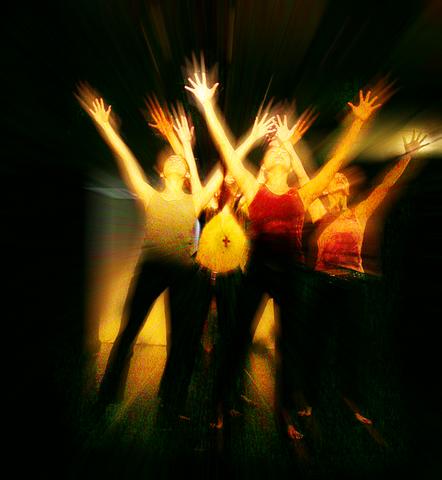Elizabeth Cameron Dalman became the pioneer of modern dance in Australia when she founded the Australian Dance Theater in 1965. It was the first modern dance group in her country and the first to be granted a government subsidy. For nearly forty years, Dalman has taught and collaborated with numerous dancers in various countries, including Taiwan.
One year after Grace Hsiao (

PHOTO: VICO LEE, TAIPEI TIMES
In Crossing Tracks II -- A Meeting of Two Cultures (
Sun and Moon, the opening piece of the show, is adopted from an Australian aboriginal legend, which represents the sun as a woman and the moon as a man.
"In modern dance, female dancers' movements are usually more activated and male dancers' more smooth. It's just like the legend," Dalman said.
This piece will be performed in Taiwan for the second time. Dalman staged it in 1971 when she was touring in Taiwan. Her performance so inspired Tsai Ruei-yuei (
Prayer, created in 1972, will probably strike a chord with audiences today with its human-rights theme and anti-war message. Based on a true story that occurred during the Troubles in Northern Ireland, the dance tells the tragic story of a Catholic girl who falls in a love with a Protestant soldier, then accidentally shoots him dead. Grace Hsiao's dancers act out the story with such precision and feeling that this piece is the highlight of the show.
The only shortcoming of this otherwise superb production is that Round-15 (
Crossing Tracks II -- A Meeting of Two Cultures will be performed at Round-15 Theater, 3F, 40-1 Chungshan N. Rd., Sec. 2, Taipei (

Most heroes are remembered for the battles they fought. Taiwan’s Black Bat Squadron is remembered for flying into Chinese airspace 838 times between 1953 and 1967, and for the 148 men whose sacrifice bought the intelligence that kept Taiwan secure. Two-thirds of the squadron died carrying out missions most people wouldn’t learn about for another 40 years. The squadron lost 15 aircraft and 148 crew members over those 14 years, making it the deadliest unit in Taiwan’s military history by casualty rate. They flew at night, often at low altitudes, straight into some of the most heavily defended airspace in Asia.

Many people in Taiwan first learned about universal basic income (UBI) — the idea that the government should provide regular, no-strings-attached payments to each citizen — in 2019. While seeking the Democratic nomination for the 2020 US presidential election, Andrew Yang, a politician of Taiwanese descent, said that, if elected, he’d institute a UBI of US$1,000 per month to “get the economic boot off of people’s throats, allowing them to lift their heads up, breathe, and get excited for the future.” His campaign petered out, but the concept of UBI hasn’t gone away. Throughout the industrialized world, there are fears that

Taiwan’s democracy is at risk. Be very alarmed. This is not a drill. The current constitutional crisis progressed slowly, then suddenly. Political tensions, partisan hostility and emotions are all running high right when cool heads and calm negotiation are most needed. Oxford defines brinkmanship as: “The art or practice of pursuing a dangerous policy to the limits of safety before stopping, especially in politics.” It says the term comes from a quote from a 1956 Cold War interview with then-American Secretary of State John Foster Dulles, when he said: ‘The ability to get to the verge without getting into the war is

Like much in the world today, theater has experienced major disruptions over the six years since COVID-19. The pandemic, the war in Ukraine and social media have created a new normal of geopolitical and information uncertainty, and the performing arts are not immune to these effects. “Ten years ago people wanted to come to the theater to engage with important issues, but now the Internet allows them to engage with those issues powerfully and immediately,” said Faith Tan, programming director of the Esplanade in Singapore, speaking last week in Japan. “One reaction to unpredictability has been a renewed emphasis on